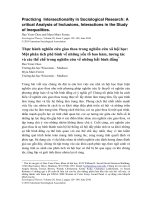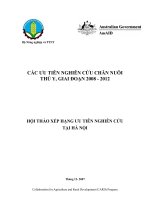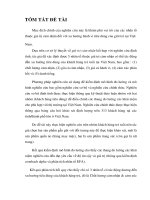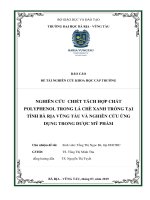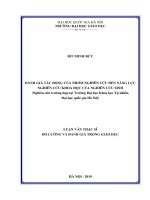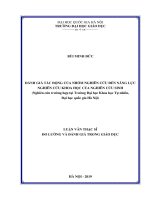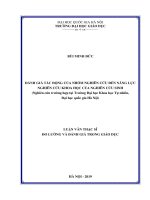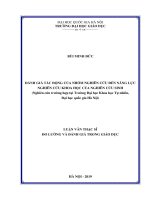Nghiên cứu các phương pháp cải tạo đất sét lòng sông sử dụng vải địa kỹ thuật - xi măng - cát
Bạn đang xem bản rút gọn của tài liệu. Xem và tải ngay bản đầy đủ của tài liệu tại đây (2.33 MB, 174 trang )
MINISTRY OF EDUCATION AND TRAINING
HO CHI MINH CITY
UNIVERSITY OF TECHNOLOGY AND EDUCATION
NGUYEN THANH TU
IMPROVEMENT METHODS TO REINFORCE
RIVERBED SILTY SOIL
USING GEOTEXTILE - CEMENT - SAND CUSHION
PH. D THESIS
MAJOR: CIVIL ENGINEERING
Ho Chi Minh City, 11/2023
MINISTRY OF EDUCATION AND TRAINING
HO CHI MINH CITY
UNIVERSITY OF TECHNOLOGY AND EDUCATION
NGUYEN THANH TU
IMPROVEMENT METHODS TO REINFORCE
RIVERBED SILTY SOIL
USING GEOTEXTILE - CEMENT - SAND CUSHION
MAJOR: CIVIL ENGINEERING - 9580201
Supervisor 1: Dr NGUYEN MINH DUC
Supervisor 2: Dr TRAN VAN TIENG
Examiner 1:
Examiner 2:
Examiner 3:
Ho Chi Minh City, 11/2023
ORIGINALITY STATEMENT
I hereby declare that this is my research work.
The data and results presented in the thesis are accurate and have never been
previously published.
Ho Chi Minh City, November 26, 2023
i
ACKNOWLEDGEMENTS
This dissertation was completed at the Faculty of Civil Engineering at the HCM
City University of Technology and Education in Vietnam. There were many obstacles
as well as excitement during the process of completing this thesis. Without the
encouragement, support, and assistance of my advisors, colleagues, and family, I
could not conduct my research.
First, I would like to thank my knowledgeable professors, Dr. NGUYEN MINH
DUC and Dr. TRAN VAN TIENG, for admitting me as a Ph.D. student. They
imparted knowledge and taught me a great deal about not only academics but also
life. Before anything else, I would like to thank Dr. Nguyen Minh Duc for inspiring,
motivating, and encouraging me to complete the thesis.
Second, I would like to thank HCM City University of Technology and
Education, Falcuty of Civil Engineering, for the resources and equipment that
allowed me to complete my research project. In addition, I would like to thank my
coworkers for their consistent support during the implementation process.
Lastly, this dissertation is dedicated to my parents, who have always provided
me with support and encouragement.
Finally, this thesis is a memorial to my parents, who have always supported and
encouraged me.
Nguyen Thanh Tu
ii
ABSTRACT
Using silty soil that was dredged from riverbeds to replace sand for road
basements is considered an alternative with many advantages. However, the riverbed
soil is soft, with low shear resistance, a high void ratio, weak permeability, and high
swelling and bearing capacity loss when saturated. Geotextile, sand cushion, and
cement methods are introduced to strengthen soil due to their popularity and
effectiveness. The laboratory experiments, including the California Bearing Ratio
(CBR), a triaxial compression test, a one-dimensional consolidation test with a
modified oedometer apparatus, and a modified direct shear test, were conducted to
investigate the swelling, CBR value, shear strength, and consolidation of reinforced
soil. Then, evaluating the applicability of these methods to reinforce the dredged soil
from the Cai Lon River would be carried out.
With the high permeability, geotextiles accelerated the soil expansion process,
and the swell decreased by 1.3 times. In addition, the CBR values increased from 1.1
to 1.5 times for the unsaturated samples and up to 3 times for the saturated samples.
Especially, samples reinforced by 2 layers got the highest CBR value. In the triaxial
compression test, the shear resistance of the unsaturated sample reinforced with three
geo-layers rose to approximately 1.6 times that of the unreinforced soil and about 2.1
times that of the saturated case due to the interaction between soil and geotextiles. In
the saturated samples, the pore water pressure increased when the displacement was
small before rapidly decreasing when slippage between the geotextile and the soil
occurred. In addition, consolidation results indicated that the reinforced sample
consolidated 1–2 times faster than the unreinforced sample of the same height.
In the one-dimensional consolidation test of reinforced soil, the height of the
specimen must be significant. Side friction between the soil and the ring must be
considered. A modified odometer apparatus was introduced to measure the friction
force between the soil and the ring. The results indicated that friction pressure
increased as the ratio of diameter to height (D/H) decreased. When the D/H ratio was
less than 2.5, the effect of friction was significant and reduced the compression
iii
pressure by up to 20% at the end of consolidation (EOP). Based on the Taylor method,
an analytical method for predicting the stress loss and coefficient of variation of the
void ratio, COV, along soil sample depth at EOP was proposed. The results indicated
that the void ratio increased with depth, and if the D/H ratio exceeded 2.5, the COV
would be less than 1.2%.
When reinforced with sand cushions, the swelling, and the dried unit weight
reduction decreased with increasing sand cushion thickness. In addition, the CBR
value was effectively increased for saturated clay rather than unsaturated samples. In
the UU triaxial compression test, the shear resistance of the reinforced soil in the
unsaturated condition increased as the horizontal pressure increased. The shear
strength of unsaturated samples with a 20 mm-thick sand cushion increased
approximately 1.9 times compared to that of unreinforced samples and about 3.3
times for the saturated case. Specifically, the pore water pressure in the saturated
samples increased when the strain was small, and then the water pressure decreased.
In addition, the consolidation results indicated that the reinforced sample consolidates
between 3.5 and 5 times faster than the unreinforced sample.
As a binder, cement reduced the swelling of riverbed clay by 1.77 to 2.5 times
when the cement ratio increased from 3 to 10%. In the case of a 28-day saturation
curing, the CBR value of the soil-cement mixture increased from 1.7 to 3.8 times that
of the soil. In the UU triaxial compression test, the shear strength of soil cement
increased in both unsaturated and saturated samples. The increase in strength of the
soil cement was due to the hydration and pozzolanic processes, which resulted in a
change in particle composition. In the case of 10% cement, the percentage of sand
granules doubled after 28 days. Brittle failure and an increase in shear resistance and
interface shear were also observed by the direct shear test of soil cement and the
modified shear test of soil cement and steel. The peak shear strength and residual
shear resistance of cement soil increased to 2.4 and 1.8 times those of clay,
respectively. In the case of the interface shear strength of cement and steel, the
maximal and residual shear resistance of cement-metal soils were 1.55 and 1.40 times
iv
greater than soil-steel, respectively. Then, a formula was proposed for estimating
shear resistance over 28 days and predicting the shear strength of the soil-cement
mixture at 28 days based on the water content and cement weight.
In summary, the results indicated that the methods of reinforcing riverbed soil
with geotextile, sand cushion, and cement are effective. Based on the results, the
cement method was the most effective compared to these methods. Soil cement
mixtures can be used as backfill material for roads with car traffic, whereas geotextile
and sand cushions can be used for roads with car-free traffic. The results of laboratory
experiments formed the theoretical basis for practical applications.
v
TĨM TẮT
Sử dụng đất sét nạo vét từ lịng sơng thay thế cho cát san lấp nền đường giao
thông được xem là giải pháp thay thế với nhiều lợi ích. Tuy nhiên, đất từ lịng sơng
là đất yếu, sức kháng cắt thấp, hệ số rỗng cao, tính thấm kém, đặc biệt là có độ trương
nở cao và mất khả năng chịu lực khi bão hoà. Vải địa kỹ thuật, đệm cát và xi măng
được sử dụng để gia tăng cường độ đất do tính phổ biến và hiệu quả. Các thí nghiệm
trong phịng, bao gồm California Bearing Ratio (CBR), cắt 3 trục trong điều kiện UU,
cố kết 1 trục với thiết bị cải tiến và cắt đất trực tiếp được hiệu chỉnh, được thực hiện
để khảo sát sự trương nở, cường độ và quá trình cố kết của đất và đất gia cường. Từ
đó, đánh giá khả năng áp dụng của các phương pháp gia cường này cho đất nạo vét
từ sơng Cái Lớn.
Vải địa kỹ thuật với tính thấm cao thúc đẩy nhanh quá trình trương nở của đất
và độ trương nở giảm đến 1.3 lần. Bên cạnh đó, giá trị CBR tăng lên từ 1.1 đế 1.5 lần
cho trường hợp khơng bão hồ và đến 3 lần khi mẫu bão hoà. Đặc biệt, mẫu gia cường
bằng 2 lớp vải cho giá trị CBR lớn nhất. Trong thí nghiệm 3 trục với các mẫu khơng
bão hồ, sức kháng cắt trong điều kiện UU của đất sét được gia cường bằng 3 lớp vải
tăng đến 1.6 lần so với mẫu không gia cường và khoảng 2.1 lần khi mẫu bão hoà do
tương tác giữa đất và vải. Trong các mẫu bão hoà, áp lực nước lỗ rỗng gia tăng khi
chuyển vị nhỏ, sau khi có sự trượt giữa vải và đất, áp lực nước giảm nhanh. Bên cạnh
đó, kết quả cố kết cho thấy, thời gian cố kết của mẫu gia cường giảm từ 1- 2 lần so
với mẫu không gia cường có cùng chiều cao.
Trong thí nghiệm cố kết một trục đất gia cường, chiều cao mẫu phải lớn. Ma sát
thành giữa đất và dao vòng cần phải được sét đến. Thiết bị cố kết cải tiến được giới
thiệu để đo được lực ma sát giữa đất và dao vòng. Kết quả cho thấy áp lực ma sát
tăng khi tỉ lệ đường kính và chiều cao D/H giảm. Ảnh hưởng của ma sát là đáng kể
khi tỉ lệ D/H nhỏ hơn 2.5 và áp lực nén giảm đến 20% tại thời điểm kết thúc quá trình
cố kết (EOP). Dựa trên phương pháp Taylor, phương pháp giải tích được đề xuất để
dự đoán sự mất mát ứng suất và hệ số sai khác hệ số rỗng, COV, dọc theo chiều sâu
vi
mẫu tại tời điểm kết thúc quá trình cố kết, EOP. Kết quả cho thấy, hệ số rỗng tăng
dần theo chiều sâu và với tỉ lệ D/H lớn hơn 2.5, giá trị COV sẽ nhỏ hơn 1.2%.
Với phương pháp đất gia cường bằng đệm cát, độ trương nở và độ giảm trọng
lượng đơn vị khô cũng giảm khi tăng bề dày đệm cát. Bên cạnh đó, giá trị CBR được
cải thiện một cách hiệu quả cho trường hợp đất bão hồ hơn là trường hợp đất khơng
bão hồ. Trong thí nghiệm 3 trục UU, sức kháng cắt trong điều kiện khơng bão hồ
của đất sét gia cường đệm cát tăng khi áp lực ngang tăng. Sức kháng cắt mẫu không
bão hoà với đệm cát dày 20mm tăng đến 1.9 lần so với mẫu không gia cường và
khoảng 3.3 lần đối với mẫu bão hoà. Đặc biệt, áp lực nước lỗ rỗng trong mẫu thí
nghiệm gia tăng khi chuyển vị nhỏ, sau đó, áp lực nước giảm mạnh. Bên cạnh đó, kết
quả cố kết cho thấy, thời gian cố kết của mẫu gia cường giảm từ 3.5- 5 lần.
Xi măng đóng vai trị như chất dính làm giảm độ trương nở đất lịng sơng từ
1.77 đến 2.5 lần khi hàm lượng xi măng gia cường tăng từ 3% đến 10%, so với trường
hợp không gia cường. Trong trường hợp ngâm bão hoà, sau 28 ngày, giá trị CBR của
xi măng đất được gia tăng từ 1.7 đến 3.8 lần so với trường hợp đất không gia cường.
Cường độ kháng cắt của xi măng đất cũng gia tăng trong điều kiện nén 3 trục UU khi
mẫu khơng bão hồ và bão hồ. Sự gia tăng cường độ của hỗn hợp xi măng đất là kết
quả của quá trình hydart và pozzolanic của xi măng và đất, dẫn đến sự thay đổi thành
phần hạt. Kết quả sau 28 ngày cho thấy, phầm trăm hạt cát tăng lên 2 lần cho trường
hợp 10% xi măng. Sự phá huỷ giòn và sự gia tăng trong sức kháng cắt và sức kháng
ma sát bề mặt được tìm thấy trong thí nghiệm cắt trực tiếp đất xi măng và thí nghiệm
cắt trực tiếp bề mặt đất xi măng và kim loại. Sức kháng cắt đỉnh và sức kháng cắt bền
của xi măng đất tăng đến 2.4 và 1.8 lần so với đất không gia cường. Các giá trị sức
kháng cắt ma sát đỉnh và bền của đất xi măng – kim loại tăng đến 1.55 lần và 1.4 lần
so với đất- kim loại. Từ đó, các cơng thức được đề xuất để dự toán sức kháng cắt theo
thời gian đến 28 ngày và dự đoán sức kháng cắt của xi măng đất tại 28 ngày theo độ
ẩm và khối lượng xi măng.
Như vậy, các kết quả cho thấy các phương pháp gia cường bằng vải địa kỹ thuật,
đệm cát và xi măng có hiệu quả trong việc cải thiện đất lịng sơng. Dựa trên các kết
vii
quả thu được, so sánh các phương pháp, phương pháp gia cường bằng xi măng cho
hiệu quả nhất. Hỗn hợp xi măng đất có thể dùng làm nền cho đường ô tô, trong khi
phương pháp vải địa kỹ thuật và đệm cát có thể sử dụng cho đường nơng thơn khơng
có ơ tơ. Các kết quả được trình bày từ các thí nghiệm ở trong phịng, là cơ sở cho việc
áp dụng thực tế.
viii
TABLE OF CONTENTS
ORIGINALITY STATEMENT .................................................................................. i
ACKNOWLEDGEMENTS ....................................................................................... ii
ABSTRACT ........................................................................................................... iii
TÓM TẮT
........................................................................................................... vi
TABLE OF CONTENTS .......................................................................................... ix
ABBREVIATION and NOTATION ...................................................................... xiii
LIST OF FIGURES................................................................................................ xvii
LIST OF TABLES ................................................................................................. xxii
CHAPTER 1: INTRODUCTION...............................................................................1
1.1. AN OVERVIEW OF THE RESEARCH DIRECTION: .................................1
1.2. REINFORCED METHODS ............................................................................2
1.2.1. Geotextile reinforcement ..................................................................................2
1.2.2. Sand cushion reinforcement .............................................................................3
1.2.3. Cement reinforcement. .....................................................................................4
1.3. THE URGENCY OF THE RESEARCH .........................................................5
1.4. SPECIFICATION OF ROAD EMBANKMENTS ..........................................6
1.4.1. Road classification ...........................................................................................6
1.4.2. Road embankment specifications .....................................................................6
1.5. LITERATURE REVIEW .................................................................................7
1.5.1. International research: ......................................................................................7
1.5.2. National research: ...........................................................................................17
1.5.3. Comments: .....................................................................................................19
1.6. RESEARCH OBJECTIVES ..........................................................................20
1.6.1. Goals of the dissertation .................................................................................20
1.6.2. Research scope ...............................................................................................22
CHAPTER 2: MATERIALS – THEORIES- MODIFIED DEVICES.....................24
2.1. MATERIAL ...................................................................................................24
2.1.1. Riverbed soil: .................................................................................................24
2.1.2. Geotextile ......................................................................................................26
2.1.3. Uniform quart sand.........................................................................................27
2.1.4. Ordinary Portland cement ..............................................................................28
2.2. EXPERIMENTAL THEORIES .....................................................................29
2.2.1. California Bearing Ratio Test ........................................................................29
2.2.2. One-dimensional consolidation theory ..........................................................30
2.2.3. Triaxial Compression Test – Modified Triaxial Apparatus: ..........................32
2.2.4. Direct shear test ..............................................................................................38
2.3. MODIFIED SHEAR BOX FOR FRICTION BETWEEN THE SOIL AND
STEEL .......................................................................................................................40
2.4. MODIFIED OEDOMETER APPARATUS FOR SIDE FRICTION
PRESSURE MEASUREMENT................................................................................41
CHAPTER 3: BEHAVIOR OF SILTY SOIL WITH AND WITHOUT
GEOTEXTILE UNDER CBR, UU, AND CONSOLIDATION TESTs ..................43
ix
3.1. INTRODUCTION ..........................................................................................43
3.2. EXPERIMENTAL PROGRAM ....................................................................44
3.2.1. CBR specimens ...............................................................................................44
3.2.2. Unconsolidated-Undrained shear strength samples in the triaxial test ..........45
3.2.3. Consolidation samples....................................................................................46
3.3. BEHAVIOR OF SILTY SOIL WITH AND WITHOUT GEOTEXTILE
UNDER THE SWELLING AND CBR TEST .........................................................47
3.3.1. Influence of the geotextile on the behavior of the soil swell .........................47
3.3.2. CBR behavior of unreinforced and reinforced silty soil by geotextile in unsoaked and soaked conditions ...................................................................................49
3.3.3. The effect of soaking on CBR behavior .........................................................51
3.4. BEHAVIOR OF SILTY SOIL WITH AND WITHOUT GEOTEXTILE ON
UU SHEAR STRENGTH UNDER TRIAXIAL TEST ............................................53
3.4.1. The shear strength behavior of silty soil unreinforced and reinforced by
geotextiles in the unsaturated condition ....................................................................53
3.4.2. The shear strength behavior of silty soil unreinforced and reinforced by
geotextiles in the saturated condition. .......................................................................55
3.4.3. Shear strength reduction of silty soil and geotextile soil due to saturation....58
3.5. CONSOLIDATION BEHAVIOR OF SILTY SOIL UNDER EFFECTS OF
SIDE FRICTION ......................................................................................................58
3.5.1. The one-dimensional consolidation behavior under the effects of side friction
pressure
......................................................................................................59
3.5.2. The total friction pressure and the friction pressure loss ratio .......................64
3.5.3. Friction between silty soil and steel, measured by a modified shear device: 66
3.5.4. Modified Taylor’s method to evaluate friction pressure loss ratio ................67
3.5.5. The non-uniform density in the specimens caused by side friction: ..............70
3.5.6. The coefficient of variation, COV: .................................................................71
3.6. BEHAVIOR OF SILTY SOIL WITH AND WITHOUT GEOTEXTILE
UNDER ONE DIMENSIONAL CONSOLIDATION TEST ...................................73
3.6.1. Primary consolidation ....................................................................................73
3.6.2. Consolidation coefficient Cv: .........................................................................74
3.7. CONCLUSION ..............................................................................................75
CHAPTER 4: BEHAVIOR OF SILTY SOIL with and without SAND CUSHION
UNDER CBR, UU, AND CONSOLIDATION TEST .............................................79
4.1. INTRODUCTION ..........................................................................................79
4.2. EXPERIMENTAL PROGRAM ....................................................................79
4.2.1. CBR specimens ...............................................................................................79
4.2.2. Unconsolidated-Undrained shear strength samples in the triaxial test ..........80
4.2.3. Consolidation samples....................................................................................81
4.3. BEHAVIOR OF SILTY SOIL WITH AND WITHOUT SAND CUSHION
UNDER THE SWELLING AND CBR TEST .........................................................81
4.3.1. Influence of the sand cushion on the swell behavior .....................................81
4.3.2. The CBR behavior of unreinforced and reinforced specimens ......................83
x
4.3.3. Influences of soaking on the CBR behavior of unreinforced and reinforced
specimens
......................................................................................................84
4.4. BEHAVIOR OF SILTY SOIL WITH AND WITHOUT SAND CUSHION
ON UU SHEAR STRENGTH UNDER THE TRIAXIAL TEST ............................85
4.4.1. The shear strength behavior of silty soil reinforced with a sand cushion in the
unsaturated condition. ...............................................................................................85
4.4.2. The shear strength behavior of silty soil reinforced by a sand cushion in the
saturated condition. ...................................................................................................88
4.4.3. Shear strength reduction of soil and sand cushion soil due to saturation: .....90
4.5. BEHAVIOR OF SILTY SOIL WITH AND WITHOUT SAND CUSHION
UNDER ONE – DIMENSIONAL CONSOLIDATION TEST ................................90
4.5.1. Estimate the height and the bottom of the sand cushion under load: .............90
4.5.2. The average pressure in soil and sand cushion ..............................................91
4.5.3. The effect of the sand cushion on the silty soil consolidation process ..........94
4.6. CONCLUSION: .............................................................................................96
CHAPTER 5: BEHAVIOR OF SILTY SOIL REINFORCED BY CEMENT
UNDER CBR, UU, CONSOLIDATION, AND SHEAR TEST ..............................98
5.1. INTRODUCTION ..........................................................................................98
5.2. EXPERIMENTAL PROGRAM ....................................................................98
5.2.1. CBR specimens ..............................................................................................98
5.2.2. Unconsolidated-Undrained shear strength samples in the triaxial test ..........99
5.2.3. Consolidation samples..................................................................................100
5.2.4. Direct shear and interface shear samples .....................................................100
5.3. BEHAVIOR OF SILTY SOIL WITH CEMENT UNDER THE SWELLING
AND CBR TEST .....................................................................................................102
5.3.1. Influence of cement on the soil’s swell behavior .........................................102
5.3.2. The CBR behavior of unreinforced and reinforced specimens ....................104
5.4. BEHAVIOR OF SILTY SOIL WITH CEMENT ON UU SHEAR
STRENGTH UNDER THE TRIAXIAL TEST ......................................................105
5.4.1. The shear strength behavior of unsaturated soil reinforced by cement: ......105
5.4.2. The shear strength behavior of silty soil reinforced by cement in the saturated
condition
....................................................................................................108
5.4.3. Shear strength reduction of silty soil and cemented soil due to saturation: .109
5.5. BEHAVIOR OF SOIL CEMENT UNDER CONSOLIDATION TEST.....110
5.6. GRAIN SIZE DISTRIBUTION OF SOIL CEMENT MIXTURE ..............114
5.7. INTERFACE SHEAR STRENGTH BEHAVIOR OF CEMENT- TREATED
SOIL UNDER CONSOLIDATED DRAINED CONDITIONS .............................118
5.7.1. Shear stress-strain behavior of cement stabilized soil under consolidateddrained conditions ...................................................................................................118
5.7.2. Behavior of interface shear strength between cement-treated silty soil and steel
under consolidated-drained conditions. ..................................................................119
5.7.3. Result of the effect of cement content on the shear strength and interface shear
strength of cement-treated soil. ...............................................................................121
xi
5.7.4. Effect of the curing period on the shear strength and the interface shear
strength of cement-treated soil. ...............................................................................128
5.8. CONCLUSION ............................................................................................130
CHAPTER 6: CONCLUSIONS and RECOMMENDATIONS ............................133
6.1. COMPARISON:...........................................................................................133
6.2. CONCLUSION ............................................................................................137
6.3. LIMITATIONS AND RECOMMENDATIONS: .......................................138
REFERENCES ........................................................................................................139
LIST OF PUBLICATIONS ....................................................................................150
xii
ABBREVIATION AND NOTATION
ABBREVIATION:
UU
: Unconditioned- Undrained Condition
CU
: Consolidated- Undrained Condition
CD
: Consolidated- Drained Condition
CBR
: California Bearing Ratio
EOP
: The end of consolidation
COV
: Coefficient of variation of void ratio
USCS
: Unified Soil Classification System
DMM
: Deep Mixing Method
LVDT
: A linear variable differential transformer
CL
: Low plasticity clay
CH
: High plasticity clay (Fat clay)
MH
: High plasticity silt
NOTATION
Basic SI units are given in parentheses.
D
: Diameter of a sample (m)
H0
: The initial height of a sample (m)
H
: The height of a sample at the end of primary consolidation (m)
e
: Void ratio of soil (dimensionless)
P
: The compression pressure due to external forces (Pa)
Paverage
: The average consolidation pressure (Pa)
R
: The reaction pressure measured at the bottom of the specimens (Pa)
z
: The depth from the top of soil sample (m)
tz
: Interface shear stress at the depth z of soil (Pa)
Pz
: average consolidation pressure at the depth z of soil (Pa)
eP
: Void ratio at the top soil layer (dimensionless)
eR
: Void ratio at the bottom soil layer (dimensionless)
xiii
eEOP
: Void ratio at the end of consolidation (dimensionless)
PL
: Plastic limit (%)
PI
: Plastic index (%)
LL
: Liquid limit (%)
Gs
: Specific gravity (dimensionless)
: Moisture unit weight (N/m3)
D50
: median particle size (m)
D10; D30; D60
d
: the diameter of a particle whose diameter is smaller than that,
accounts for 10%, 30%, 60% of the total weight, respectively (m)
: Dry unit weight (N/m3)
S
: the swelling of soil (%)
S96h
: The percent swell after 96 hours of soaking (%)
s
: Vertical swell (m)
CBR1, CBR2
: CBR at 2.54 mm and 5.09 mm of penetration, respectively
RCBR
: The strength ratio was the ratio of the CBR of the reinforced
specimen to that of the unreinforced specimen (dimensionless).
: Value of pressure in piston (MPa) at 2.54 mm and 5.09 mm in CBR
test, in turn (Pa)
: Compression pressure in soil (Pa)
1
: The vertical (longitudinal) compression pression (Pa)
2, 3
: The horizontal compression pression (Pa)
U
: Pore water pressure (Pa)
: Increasement of compression pressure in soil (Pa)
u
: Increasement of pore water pressure in soil (Pa)
Cc
: Compression index (dimensionless)
Cv
: Coefficient of consolidation (m2/s)
Hdrainage
: The length of the drainage route (m)
T100; T90; T50
: Time related to the specific degree of consolidation (100%, 90%
and 50% of consolidation) (second)
: Elastic modulus (Pa)
P1; P2
E
xiv
: Axial strain (%)
ΔH
: Soil settlement (m)
A
: Cross-sectional area (m2)
A1
: The average cross-sectional area due to lateral expansion (m2)
c
: The cohesion of soil (Pa)
: Internal friction angle of soil (degree)
int
: Interface friction angle between the clay and the steel (degree)
Kp
: Passive earth pressure coefficient (dimensionless).
Su
: Shear strength in the UU triaxial test of saturated samples (Pa)
hgeo
: The geotextile spacing (m)
Dpiston
: the diameter of the load piston in CBR test (m)
Ruf
Tshear
: The shear strength increasement in the unsaturated condition due to
reinforcement (dimensionless).
: The shear strength increasement in the saturated condition due to
reinforcement (dimensionless).
: Shear strength reduction due to saturation (%)
K0
: The horizontal expansion coefficient of soil (dimensionless).
P0
: The pre-consolidation pressure (Pa)
sd_Po
: the standard deviation of the pre-consolidation pressure (Pa)
hsand
: The height of sand cushion at EOP (m)
Pb_sand
: the bottom pressure of the sand cushion (Pa)
Pt_sand
: the top pressure of the sand cushion (Pa)
Cc_sand
: compression index of the sand (dimensionless)
Rf
Po_sand
e0_sand
pre-consolidation pressure of sand at the void ratio e0_sand (Pa)
: the void ratio of sand at the pre-consolidation pressure
(dimensionless).
Ho_sand
: The initial height of the sand cushion (m)
K0_sand
: the coefficient of the sand cushion at rest (dimensionless).
’Int_sand
: interface friction angle between sand and ring (degree)
xv
Pave_soil
: The average pressures at the center of all the soil (Pa)
loss pressure
: The loss pressure due to side friction (degree)
SD_H/H
: factional error of estimated height (%)
SD_P/Po_average : factional error of pre-consolidation pressure (%)
SD_e
: The standard deviation of the void ratio (dimensionless)
r
: The reduction due to side friction (dimensionless)
H’
: The height of specimens at EOP without side friction effects (m)
: The height factor accounts for the effects of side friction.
(dimensionless)
cm
: Cement content (%)
Rs
: shear strength ratio of soil-cement mixture (dimensionless).
IEF
: interface efficiency ratio (dimensionless)
qu
: the unconfined compressive strength of cement-treated soil (Pa)
xvi
LIST OF FIGURES
Figure 1.1: Geotextile and soil reinforced by a layer of geotextile ...........................3
Figure 1.2: Soil reinforced by a sand cushion .............................................................4
Figure 1.3: The appearance of soil-cement as a base [1] ............................................5
Figure 1.4: The laboratory experiments in this study. ..............................................22
Figure 2.1: Grain size distribution of the soil ...........................................................25
Figure 2.2: Construction diagram for drying mud according to methods (a)
conventional drying method; (b) a layer of sand cushion .........................................25
Figure 2.3: Process of recycling soil .........................................................................25
Figure 2.4: The settlement of a geotextile layer under pressure ...............................26
Figure 2.5: Sand's grain-size distribution ..................................................................27
Figure 2.6: The settlement of a 5-, 10-, and 20-mm sand cushion under pressure ...28
Figure 2.7: Mold with extension collar and spacer disc ...........................................29
Figure 2.8: Change of pore water pressure during the consolidation process ..........31
Figure 2.9: One-dimensional schematic ....................................................................31
Figure 2.10: A modified triaxial compression aparatus ............................................34
Figure 2.11: Direct shear apparatus ..........................................................................39
Figure 2.12: Modified shear box for interface shear strength ...................................40
Figure 2.13: Modified oedometer apparatus for side friction pressure measurement
...................................................................................................................................41
Figure 3.1: Geotextile layers in reinforced and unreinforced CBR specimens. ........44
Figure 3.2: Geotextile layers in reinforced and unreinforced samples in the UU test.
...................................................................................................................................45
Figure 3.3: Uninforced and geotextile-reinforced samples in UU the test ...............45
Figure 3.4: Samples to investigate side friction ........................................................46
Figure 3.5: Samples reinforced by geotextile in one-dimension consolidation ........46
Figure 3.6: Percent swelling of soil and geotextile-soil specimens during soaking .47
Figure 3.7: The swell velocity (a) during the initial 20 hours and (b) after 20 hours
...................................................................................................................................48
Figure 3.8: The piston stress vs. penetration. ............................................................49
Figure 3.9: The relationship between strength ratio and geotextile spacing.............50
Figure 3.10: Deviation stress versus axial strain of unreinforcement and
reinforcement with geotextile in the unsaturated condition ......................................53
Figure 3.11: The vertical versus lateral pressure of silty soil and geotextile soil at
failure in unsaturated condition. ................................................................................54
Figure 3.12: Shear strength increasement versus lateral pressure in the unsaturated
condition. ...................................................................................................................55
Figure 3.13: The deviation stress and axial strain of soil and soil reinforced by
geotextile in the saturated condition .........................................................................56
Figure 3.14: The excess pore water pressure and axial strain of soil and soil reinforced
by geotextile in the saturated condition ....................................................................56
Figure 3.15: The shear strength increasement Rf and excess pore water pressure of
soil and soil reinforced by geotextile in the saturated condition. .............................57
xvii
Figure 3.16: Shear strength reduction Tshear due to saturation of silty soil with and
without geotextile ......................................................................................................58
Figure 3.17: Axial strain vs. time under 99.5kPa of compression pressure..............59
Figure 3.18: Variation of time corresponding to 100% primary consolidation, T100,
with square maximum drainage distance, Hdrainage2, under different compression
pressures. The empty and solid symbols indicate the specimens with a 50 mm and 75
mm diameter, respectively. .......................................................................................60
Figure 3.19: Consolidation coefficient value with the average consolidation pressure.
...................................................................................................................................61
Figure 3.20: Compression curves (eEOP-logP) without pressure correction for friction
pressure loss. .............................................................................................................62
Figure 3.21: Compression curves (eEOP-logPaverage) of soil specimens after pressure
correction for friction pressure loss. .........................................................................63
Figure 3.22: The estimated pre-consolidation pressure with fractional error / ..64
Figure 3.23: The temporal variation of total friction pressure. .................................64
Figure 3.24: The friction pressure loss ratio at the end of the primary consolidation.
...................................................................................................................................65
Figure 3.25: Interface shear strength behavior and failure envelopes of shear strength
and interface shear strength under different normal pressures. ................................66
Figure 3.26: Non-uniform void ratio condition caused by side friction at EOP.......68
Figure 3.27: Comparison between the experimental and predicted height of soil
specimens at EOP using the height factor ................................................................69
Figure 3.28: Comparison between the measured and predicted void ratio ...............71
Figure 3.29: The variation of void ratio with the depth with the diameter (a) D =
75mm and (b) D = 50m under the compression pressure, P = 99.5 kPa ..................71
Figure 3.30: Variation of COV with the compression pressure on the top of soil
specimens with different ratio D/H0 ..........................................................................72
Figure 3.31: Variation of COV with the friction loss ratio at EOP of soil specimens
obtained from different studies. ................................................................................73
Figure 3.32: The required time to obtain a) 100% (T100) and b) 90% (T90)
consolidation of geotextile samples ..........................................................................74
Figure 3.33: The consolidation coefficients Cv vs. average pressure of geotextile soil
samples ......................................................................................................................75
Figure 4.1: The arrangement of the sand cushion with varied thickness reinforced
CBR specimens in unsoaked and soaked conditions. ...............................................80
Figure 4.2: The arrangement of sand cushions in the UU test. .................................80
Figure 4.3: The sand cushion specimens in the UU test. ..........................................80
Figure 4.4: Samples reinforced by sand cushions in one-dimensional consolidation
...................................................................................................................................81
Figure 4.5: Swell behavior with time of unreinforced and reinforced specimens (a)
percent swell and (b) velocity of swell .....................................................................81
Figure 4.6: Corrected stress in the piston of the specimen (a) without soaking and (b)
soaking condition ......................................................................................................83
xviii
